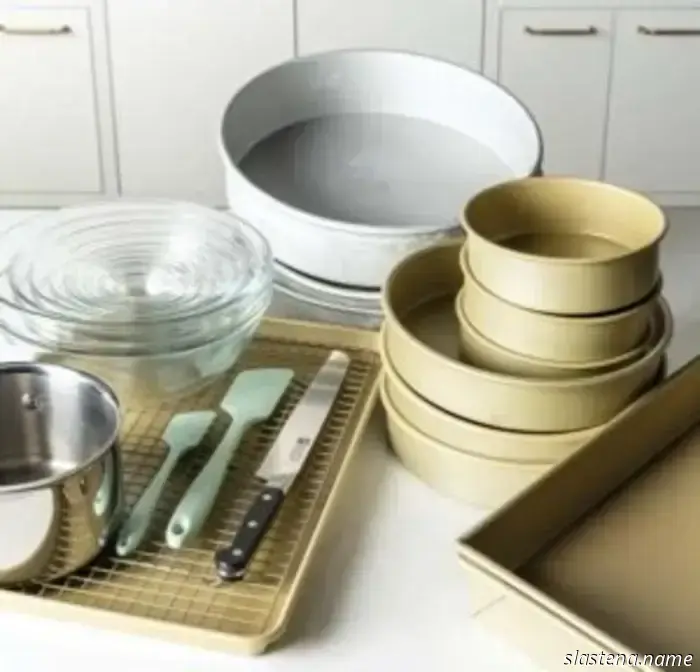
Baking School Detailed: Strawberries and Cream Wedding Cake - Bake from Scratch
Exceptional recipes depend on quality ingredients. Here’s how the components of our recipes play a crucial role in creating this exquisite wedding cake.
UNSALTED BUTTER: Butter adds fat, contributing to tenderness and flavor, while also aiding in aeration when creamed with sugar. Its semisolid state in cake batter traps air, which expands during baking, resulting in a lighter texture. In buttercream, its ability to emulsify creates a smooth and stable frosting.
GRANULATED SUGAR: Sugar serves more purposes than just sweetness; it affects structure and texture as well. It binds with water molecules, minimizing gluten formation for a more tender crumb. It also supports aeration during creaming, helping to incorporate air pockets that aid in the cake’s rise.
NEUTRAL OIL: Oil brings moisture and prevents the cake from drying out. Unlike butter, oil stays liquid at room temperature, providing a softer texture and extending the cake’s freshness.
EGG WHITES: Egg whites add structure with their protein content, which solidifies when heated, stabilizing the cake. Without egg yolks, the cake achieves a finer, denser crumb and a lighter texture. The lack of yolks lessens richness slightly, but this is balanced by the addition of sour cream and oil. The omission of yolks also keeps the cake a brighter white, as the yellow pigment in yolks would otherwise alter its color.
VANILLA EXTRACT: Vanilla boosts flavor complexity, providing warmth and aromatic depth to the cake. Its alcohol content helps disperse flavors more effectively throughout the batter.
ALL-PURPOSE FLOUR: Flour is essential for forming the cake’s structure through gluten development. The ratio of flour, fat, and sugar influences the final texture; too much flour can lead to toughness, while too little may cause collapse.
BAKING POWDER: This chemical leavening agent releases carbon dioxide when combined with liquid and exposed to heat. This expansion enhances the air pockets created during creaming, causing the cake to rise. If it’s double-acting, it releases gas both when mixed and baked, ensuring consistent rising.
KOSHER SALT: Salt enhances flavor by balancing sweetness and amplifying other tastes. It also slightly strengthens the gluten network, improving texture.
WHOLE MILK: The combination of water, fat, and proteins affects structure and tenderness. Water hydrates the flour for gluten development, while milk proteins contribute to a fine crumb. The fat content results in a softer texture, and the natural sugars promote light caramelization for a golden crust. Maintaining room temperature is essential for blending seamlessly into the batter without curdling and ensuring even fat distribution.
SOUR CREAM: The acidity in sour cream weakens gluten development, resulting in a more delicate and tender cake. It also reacts with baking powder to generate carbon dioxide, providing extra lift to the batter. The fat content adds richness, and the tanginess balances the cake’s sweetness.
CONFECTIONERS’ SUGAR: Unlike granulated sugar with its larger crystals, confectioners' sugar is finely ground, often mixed with a small amount of cornstarch to prevent clumping. This ultra-fine texture dissolves easily into buttercream, ensuring a silky finish. In frostings, it stabilizes fat and air, maintaining structure. The cornstarch helps absorb excess moisture, preventing buttercream from weeping or becoming grainy over time.
HEAVY WHIPPING CREAM: Comprising mostly butterfat, heavy whipping cream (at least 36%) adds a luxurious richness to buttercream and a light, airy texture to the strawberry filling. When whipped, the fat traps air, forming a structure that is both stable and melt-in-your-mouth soft.
PURPLE LIQUID FOOD COLORING: Butter inherently has a yellow tint due to beta-carotene in the milk fat. To achieve a pure white frosting, a small drop of purple food coloring counteracts this yellow hue. This works since yellow and purple are opposite each other on the color wheel, producing a neutral white rather than a warm, buttery yellow. The trick is only to use a minuscule amount; too much will shift the frosting to a lilac color.
WATER: In the Vanilla Simple Syrup, water serves as a universal solvent, dissolving sugar to create a liquid that penetrates the cake layers, keeping them moist without sogginess. It also contributes to caramelization; when sugar and water heat together, water slows browning, ensuring even cooking. In cake batter, water from milk and eggs influences gluten formation and starch gelatinization, both critical for structure.
FRESH STRAWBERRIES: Containing about 90% water, strawberries can be challenging in fillings—too much liquid may lead to a runny consistency. Roasting them reduces excess water while concentrating their natural sugars and deepening their flavor. Their natural acidity enhances the cake's overall balance. The pectin softens during roasting, providing a

Other articles
Baking School Detailed: Strawberries and Cream Wedding Cake - Bake from Scratch
The Baking In-Depth module for this month honors the classic beauty of the tiered wedding cake, a focal point for any celebration.
